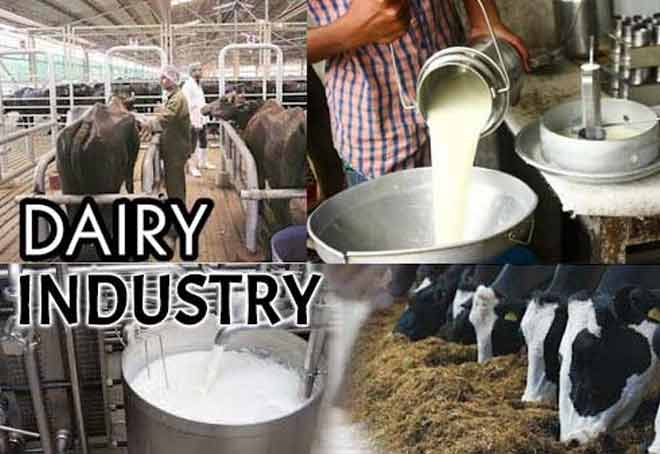Introduction
India’s dairy sector is a remarkable story of success. While in most agricultural domains Indian farmers lag behind developed countries in terms of productivity and cost competitiveness, milk production stands out as a sector where India has not only achieved self-sufficiency but also maintained global competitiveness.
- Today, with an output of 239 million metric tonnes (2024), India is the largest producer of milk in the world, contributing nearly 25% of global production. It accounts for around 5% of the agricultural GDP and supports the livelihoods of more than 80 million farming households.
- This unique model is not based on large industrial farms, but rather on small and marginal farmers who feed their cattle crop residues and by-products in a low-cost system. Hence, despite India’s per-cow milk yield being only 1.64 tonnes per year—much lower than the US (11 tonnes), Europe (7.3 tonnes), and New Zealand (4.6 tonnes)—Indian milk remains competitive in terms of production costs and market prices.
India’s Dairy Model: Uniqueness and Achievements:
1. Smallholder-based production system
o More than 50 million small and marginal farmers are engaged in dairying.
o Most farmers own 2–3 animals, with milk serving as a supplementary source of income.
2. Crop-residue-based feeding
o Instead of expensive cattle feed, farmers use crop residues, straw, and agro by-products.
o This keeps production costs low and reduces cash outflow.
3. Network of cooperatives
o Models like Amul and the Gujarat Cooperative Milk Marketing Federation (GCMMF) have linked farmers with markets, ensuring higher returns.
o Amul returns more than 75% of the retail price to farmers, whereas in the US farmers receive only about 35%.
4. Women’s empowerment and livelihood
o Over 80 million farming families, especially women, are associated with dairying.
o Self-Help Groups (SHGs) and women’s cooperatives have played a major role in enhancing income and social status.
5. Price competitiveness and consumer benefit
o In the US, farmgate prices for milk with 3.5% fat average around ₹36.7 per litre, whereas farmers in Maharashtra earn about ₹34 per litre for comparable quality.
o In Europe, the same price is as high as ₹55.6 per litre.
o At the consumer level, whole milk retails in the US at around ₹100 per litre, while Amul’s toned milk is available for ₹55–57 per litre.
Government Initiatives
Both the central and state governments have launched numerous schemes for dairy development—
|

Challenges in Sustaining Competitiveness:
1. Low productivity
o India’s average milk yield is only 1.64 tonnes per cow annually.
o Far below the US (11 tonnes) and Europe (7.3 tonnes).
2. Limitations of the low-cost model
o Competitiveness currently depends on cheap and family labour.
o As rural labour grows scarce and costlier, this model is becoming unsustainable.
3. Fodder and nutrition shortage
o Lack of protein-rich and nutritious feed constrains productivity.
o India lacks the vast pastures available in New Zealand.
4. Animal health and diseases
o Foot-and-Mouth Disease (FMD) and Brucellosis reduce yields.
o Veterinary health services remain inadequate.
5. Highly fragmented production structure
o The US produces milk from only 24,470 large farms, while India depends on 50 million farmers and 110 million animals.
o This prevents economies of scale.
6. Lack of processing and exports
o Only 20% of milk is processed in the organized sector.
o India’s share in global dairy exports is just 0.3%.
7. Impact of climate change
o Rising heat and “heat stress” affect fertility and milk output.
8. Technological backwardness
o Compared to Western nations, automation, IoT, and digital tracking are minimal in India.
Milk sector in India vs. the World:
India’s model remains sustainable for now, but competitiveness cannot continue to rely solely on cheap labour. |
Way Forward: Reforms and Policy Suggestions:
1. Breed improvement and reproductive technology
o Develop productive breeds using IVF, embryo transfer, and genomic selection.
o Create high-yielding lines of indigenous breeds.
2. Fodder revolution
o Cultivation of protein-rich grasses and leguminous fodder crops.
o Scientific processing of crop residues to make fodder available.
3. Selective mechanisation
o Affordable dairy equipment through farmer collectives.
o Use of energy-efficient technologies.
4. Animal health and vaccination
o Adopting a “One Health Approach” to prevent zoonotic diseases.
o Expanding mobile veterinary services.
5. Digital and smart technologies
o Blockchain-based milk tracking, sensor-based feeding, and smart shed management.
o Mobile apps for farmers to access market prices and animal health support.
6. Expansion of cooperatives
o Replicating the Amul model nationwide.
o Ensuring farmers receive the maximum share of consumer prices.
7. Global export strategy
o Branding Indian ghee, paneer, and curd with GI tags for international markets.
o Protecting dairy interests in Free Trade Agreement (FTA) negotiations.
Conclusion
India’s dairy sector is a foundation of livelihood, nutrition, and inclusion. It is among the few areas of agriculture where India has not only achieved self-reliance but also demonstrated global efficiency. Yet, future competitiveness cannot rest on cheap labour alone. Breed improvement, nutrition management, technological innovation, and selective mechanisation are essential.
| Main Question: “India’s dairy sector is one of the few areas of agriculture that has remained globally competitive. However, its sustainability cannot rely solely on cheap labour and family workforce.” In the light of this statement, critically examine the basis of competitiveness of India’s dairy sector, the current challenges it faces, and the reform measures required for the future. (250 words) |







